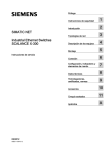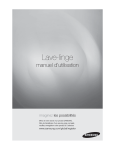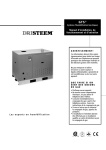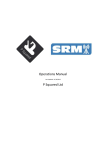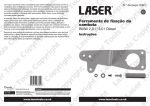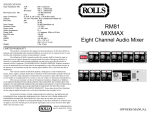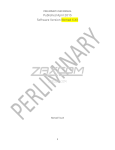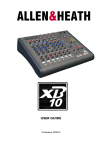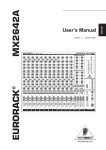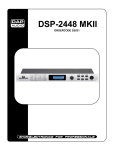Download DAPAudio LIVE 16 Product guide
Transcript
LIVE 16 ORDERCODE D2211 Congratulations! You have bought a great, innovative product from DAP Audio. The DAP Audio LIVE 16 brings excitement to any venue. Whether you want simple plug-&-play action or a sophisticated show, this product provides the effect you need. You can rely on DAP Audio, for more excellent audio products. We design and manufacture professional audio equipment for the entertainment industry. New products are being launched regularly. We work hard to keep you, our customer, satisfied. For more information: [email protected] You can get some of the best quality, best priced products on the market from DAP Audio. So next time, turn to DAP Audio for more great audio equipment. Always get the best -- with DAP Audio ! Thank you! DAP Audio DAP Audio LIVE 16™ Product Guide Warning..…...................................................................................………………………………………….. Safety-instructions………………………………………………………………………………………….…. Operating Determinations……………………………………………………………………………………. 2 2 3 Description..…..............................................................................……….………………………………… Features………………………………………………………………………………….………………….…. Overview ..…………………………………………………………………………………….………....……. 4 4 4 Installation...............................................................................…...……………………………………..…. Installation....................................................………………………………………..………..................... 5 5 Set Up and Operation.....................................................................……..…………………………….….. Input Channel Section..............................................................................................…...........……...... Stereo Channel Section…........................................................................................................…….... Master Section.….................................................................................................................………..... Mixer output section...............................................…………………………………...................……..... 5 6 8 10 12 Connection Cables..............................….......................................………..………….…….………….…. 13 Maintenance………..............................….......................................………..………….…….………….…. 14 Troubleshooting………..............................…................................………..………….…….………….….. 14 Block Diagram………..............................…................................………..………….…….………….…….. 15 Product Specifications.................................................................……………….…….………………….. 16 1 WARNING CAUTION! Keep this system away from rain and moisture! FOR YOUR OWN SAFETY, PLEASE READ THIS USER MANUAL CAREFULLY BEFORE YOUR INITIAL START-UP! SAFETY INSTRUCTIONS Every person involved with the installation, operation and maintenance of this system has to: be qualified follow the instructions of this manual CAUTION! Be careful with your operations. With a dangerous voltage you can suffer a dangerous electric shock when touching the wires! Before you initial start-up, please make sure that there is no damage caused by transportation. Should there be any, consult your dealer and do not use the system. To maintain perfect condition and to ensure a safe operation, it is absolutely necessary for the user to follow the safety instructions and warning notes written in this manual. Please consider that damages caused by manual modifications to the system are not subject to warranty. This system contains no user-serviceable parts. Refer servicing to qualified technicians only. IMPORTANT: The manufacturer will not accept liability for any resulting damages caused by the non-observance of this manual or any unauthorized modification to the system. • • • • • • • • • • • • • • • • Never let the power-cord come into contact with other cables! Handle the power-cord and all connections with the mains with particular caution! Never remove warning or informative labels from the unit. Never use anything to cover the ground contact. Never leave any cables lying around. Do not insert objects into air vents. Do not connect this system to a dimmerpack. Do not switch the system on and off in short intervals, as this would reduce the system’s life. Do not open the device and do not modify the device. Do not drive the inputs with a signal level bigger, than required to drive the equipment to full output. Only use system indoor, avoid contact with water or other liquids. Avoid flames and do not put close to flammable liquids or gases. Always disconnect power from the mains, when system is not used. Only handle the power-cord by the plug. Never pull out the plug by tugging the power-cord. Always operate the unit with the AC ground wire connected to the electrical system ground. Make sure you don’t use the wrong kind of cables or defective cables. Make sure that the signals into the mixer are balanced, otherwise hum could be created. Make sure you use DI boxes to balance unbalanced signals; All incoming signals should be clear. 2 • • • • • • • • • • • • • Make sure that the available voltage is not higher than stated on the rear panel. Make sure that the power-cord is never crimped or damaged. Check the system and the power-cord from time to time. In system setup, the amplifier's output power must be 50%-100% more than the loaded loudspeakers rated power. Please turn off the power switch, when changing the power cord or signal cable, or select the input mode switch. Extreme frequency boosts in connection with a high input signal level may lead to overdriving your equipment. Should this occur, it is necessary to reduce the input signal level by using the INPUT control. To emphasize a frequency range, you don’t necessarily have to move its respective sliding control upward; try lowering surrounding frequency ranges instead. This way, you avoid causing the next piece of equipment in your sound path to overdrive. You also preserve valuable dynamic reserve (“headroom”) Avoid ground loops! Always be sure to connect the power amps and the mixing console to the same electrical circuit to ensure the same phase! If system is dropped or struck, disconnect mains power supply immediately. Have a qualified engineer inspect for safety before operating. If the system has been exposed to drastic temperature fluctuation (e.g. after transportation), do not switch it on immediately. The arising condensation water might damage your system. Leave the system switched off until it has reached room temperature. If your Dap Audio device fails to work properly, discontinue use immediately. Pack the unit securely (preferably in the original packing material), and return it to your Dap Audio dealer for service. Repairs, servicing and electric connection must be carried out by a qualified technician. For replacement use fuses of same type and rating only. WARRANTY: Till one year after date of purchase. OPERATING DETERMINATIONS If this system is operated in any other way, than the one described in this manual, the product may suffer damages and the warranty becomes void. Any other operation may lead to dangers like short-circuit, burns, electric shock, etc. You endanger your own safety and the safety of others! Improper installation can cause serious damage to people and property ! 3 Description of the device Features The LIVE 16 is a mixer from Dap Audio. • 8 Mono Input Channels with goldplated XLR connectors and balanced Line Inputs • Ultra-low noise Mic pre-amps with +48 V Phantom Power • 4 Stereo Input channels with balanced TRS jacks • 8 additional multi-functional stereo Line inputs • Extremely high headroom, offering a more dynamic range • Balanced inputs for highest signal integrity • Ultra musical 3-band EQ on all channels • Peak LEDs all Mono and Stereo channels • 2 AUX Sends per channel for external effects and monitoring • Separate Master Mix, Control Room and Headphone outputs • 2-Track inputs assignable to Master Mix, Control Room and Headphone outputs • Highly accurate 10 LEDs output level indicator • Rugged design power supply ensures superior signal integrity Overview Fig. 1 4 Installation Remove all packing materials from the LIVE 16. Check that all foam and plastic padding is removed. Connect all cables. Always disconnect from electric mains power supply before cleaning or servicing. Damages caused by non-observance are not subject to warranty. Set Up and Operation Before plugging the unit in, always make sure that the power supply matches the product specification voltage. Do not attempt to operate a 120V specification product on 230V power, or vice versa. 5 Input-Channel-Section 1) MIC Electronically balanced XLR-connector input socket. For connecting low signal sources such as microphones or other low impedance devices. +48V Phantom Power on each input MIC socket. 2) LINE Balanced or unbalanced 1/4 (Ø 6.35mm) Stereo jack input socket. For connection with high level sound sources, such as keyboards, electric guitars, electronic musical instruments or audio playback units. Mono-connectors can also be used for automatic signal unbalancing. When connecting a turntable, only use an external R.I.A.A. Preamplifier. 3) INSERT Stereo-Jack-connector (Ø 6,3 mm). For connecting the input and output of a remote device such as a noise gate, compressor or equalizer in series with the channel. The command is only available in mono channels. TIP = Signal input, Ring = MIC Signal output 4) TRIM) With this function you can adjust the input sensitivity (-∞ to +20 dB) of each channel in order to get a constant level signal. 5) HIGH: Controls the high range of signals (+15 dB). When the knob is centrally positioned (zero point), sound tone remains unchanged. Turn the knob anti-clockwise to gradually reduce high frequencies (vocals with less hiss, reduction of background noise, cymbals less cutting, etc.). Turn the knob clockwise to boost high frequencies (sound are highlighted, vocals are more intelligible, signal harmonics are emphasized). 6) MID: Controls the mid range of signals (+15 dB). When the knob is centrally positioned (zero point), sound tone remains unchanged. Turn the knob anti-clockwise to gradually reduce mid frequencies (reduction of mid part of sound, tones at extremes of high and low ranges are emphasized, typical of dance music tones). Turn the knob clockwise to boost mid frequencies (sound body is highlighted, greater overall sound power and more nasal tone). 7) LOW: Controls the low range of signals (+15 dB). When the knob is centrally positioned (zero point), sound tone remains unchanged. Turn the knob anti-clockwise to gradually reduce low frequencies (boom is neutralized, excessively low sounds are removed). Turn the knob clockwise to boost low frequencies (more full-bodied sound, highlighting of main signal frequencies, percussive sound more pronounced). 6 8) AUX1 This is normally placed after the EQ section and before the channel fader (PREFADE, POST-EQ), and is therefore unaffected by the fader position and routing status. This makes it particularly suitable for foldback or monitor feeds, which need to be controlled separately from the main PA Mix. 9) AUX2 This is normally placed after the EQ section and before the channel fader (PREFADE, POST-EQ), and therefore follows any changes in the fader level. This is normally used to drive effect-processing units, which are fed back into the mixer and which must fade out with the input channel. 10) PAN Use this control if you want to adjust the signal stereo position. Turn the knob to the left (L) or right (R) to vary the proportion of the signals send to the Left or Right and G1 or G2. 11) PEAK. 0dB-10dB The red LED lights up, when the signal level of the tone control is 5dB below clipping point. 12) PFL Used for headphone monitoring of each channel, regardless of the main mix. The PFL (Pre-Fader-Listen)-function allows the user to listen to the level before fader control; subsequent adjustment of the fader control (15) will not modify the level. This control is useful during channel gain adjustment. 13) L-R When you push this button, you can route the signal to the L/R fader. 14) G1-2 When you push this button, you can route the signal to the Group 1/2 fader. 15) Channel Fader The fader adjusts channel signal level to be sent to the master Fader-Control L-R (35). Set the slider to 0dB for maximum signal level; slide downwards to lower and eventually eliminate the signal. For the best result, set the slide control to 3/4 of travel upwards. 7 Stereo-Channel Section 16) LINE L / R 1/4 jack line input for L/R balanced stereo line level signals.status. When using mono line signal, use the L side. When using stereo line signal, use the L and R side. 17) TRIM) With this function you can adjust the input sensitivity (-∞ to +20 dB) of each channel in order to get a constant level signal. 18) HIGH: Controls the high range of signals (+15 dB). When the knob is centrally positioned (zero point), sound tone remains unchanged. Turn the knob anti-clockwise to gradually reduce high frequencies (vocals with less hiss, reduction of background noise, cymbals less cutting, etc.). Turn the knob clockwise to boost high frequencies (sound are highlighted, vocals are more intelligible, signal harmonics are emphasized). 19) MID: Controls the mid range of signals (+15 dB). When the knob is centrally positioned (zero point), sound tone remains unchanged. Turn the knob anti-clockwise to gradually reduce mid frequencies (reduction of mid part of sound, tones at extremes of high and low ranges are emphasized, typical of dance music tones). Turn the knob clockwise to boost mid frequencies (sound body is highlighted, greater overall sound power and more nasal tone). 20) LOW: Controls the low range of signals (+15 dB). When the knob is centrally positioned (zero point), sound tone remains unchanged. Turn the knob anti-clockwise to gradually reduce low frequencies (boom is neutralized, excessively low sounds are removed). Turn the knob clockwise to boost low frequencies (more full-bodied sound, highlighting of main signal frequencies, percussive sound more pronounced). 8 21) AUX1 This is normally placed after the EQ section and before the channel fader (PREFADE, POST-EQ), and is therefore unaffected by the fader position and routing status. This makes it particularly suitable for foldback or monitor feeds, which need to be controlled separately from the main PA Mix. 22) AUX2 This is normally placed after the EQ section and before the channel fader (PREFADE, POST-EQ), and therefore follows any changes in the fader level. This is normally used to drive effect-processing units, which are fed back into the mixer and which must fade out with the input channel. 23) BAL The BAL control sends the post fader signal to either the Left or Right and G1 or G2. When the knob is centrally positioned (zero point), an equal amount of signal is sent to the Left or Right and G1 or G2. 24) PEAK. 0dB-10dB The red LED lights up, when the signal level of the tone control is 5dB below clipping point. 25) PFL Used for headphone monitoring of each channel, regardless of the main mix. The PFL (Pre-Fader-Listen)-function allows the user to listen to the level before fader control; subsequent adjustment of the fader control (15) will not modify the level. This control is useful during channel gain adjustment. 26) L-R When you push this button, you can route the signal to the L/R fader. 27) G1-2 When you push this button, you can route the signal to the Group 1/2 fader. 28) STEREO Channel Fader The fader adjusts channel signal level to be sent to the master Fader-Control L-R (35). Set the slider to +15dB for maximum signal level; slide downwards to lower and eventually eliminate the signal. For the best result, set the slide control to 3/4 of travel upwards. 9 MASTER-Section 29) Output Level Indicator This is a level indicator, which shows the output level of the Left & Right channel and G1 & G2. 30) Output Level Indicator Switch L/G1 and R/G2 With this switch you can select L/R and G1/G2. 31) AUX 1 RETURN / AUX 2 RETURN Return level of AUX 1/2 into the mixer. 32) BAL The BAL control sends the post fader signal to either the Left or Right and G1 or G2. When the knob is centrally positioned (zero point), an equal amount of signal is sent to the Left or Right and G1 or G2. 33) L-R When you push this button, you can route the signal to the L/R fader. 34) G1-2 When you push this button, you can route the signal to the Group 1/2 fader. 35) Output Master Fader (L/R) This is the master fader for adjusting the channel signal level of the Left / Right output. Set the slider to +15dB for maximum signal level; slide downwards to lower and eventually eliminate the signal. For the best result, set the slide control to 3/4 of travel upwards. 10 36) POWER Switch The Power LED will illuminate when you push this switch. 37) PHANTOM POWER Switch The Power LED will illuminate when you push this switch. Pressing this switch applies 48V DC to all microphone input channel connectors, for remote powering of condenser microphones. 38) HEADPHONES / CONTROL ROOM Level This is a single volume control, which controls the level to the headphones and main monitors. 39) HEADPHONE Function Select Switch (PFL / L-R / G1-2) With this switch you can determine, which signal you wish to listen on the headphone. You can select PFL, L-R or G1-2. 40) AUX SEND 1 / 2 This is used for adjusting the volume of AUX sound, when sending an AUX signal to a jack. 41) TAPE LEVEL You can adjust the volume of TAPE in signal when connecting TAPE in. 42) OUTPUT G1-2 FADERS With this fader you can adjust the G1-2 output level. 11 MIXER Output-Section 43) STEREO AUX RETURNS & AUX SENDS These can be used to connect all kinds of effects. 44) G1-G2 OUT On these outputs is connected, the signal which is set with the G1-2 faders. These can be used to connect all kinds of effects. 45) CTRL R OUT The phone signal follows the control room output. 46) STEREO OUT JACK (L / R) The sound can be send to a main amplifier through XLR & 1/4 jack. 47) TAPE INPUT JACK You can connect i.e. a cassette deck or other 2 track playback equipment on this jack. 48) REC OUT JACK This jack is to be connected with a cassette deck when recording the mixed output. 49) PHONES JACK This is used for monitoring the master signal and individually monitoring each channel with PFL, L / R and G1-2. 50 50) POWER JACK This is power supply jack (2xAC 18 ~ 20V) 12 Connection Cables Take care of the connector cables, always holding them by the connectors and avoiding knots and twists when coiling them: This gives the advantage of increasing their life and reliability, which is always to your advantage. Periodically check that your cables are in good condition, that they are correctly wired and that all their contacts are perfectly efficient: a great number of problems (faulty contacts, ground hum, discharges, etc.) are caused entirely by using unsuitable or faulty cables. Headphones Unbalanced mono 1/4” jack plug Balanced mono 1/4” jack plug Compensation of interference with balanced connections 13 Maintenance The DAP Audio LIVE 16 requires almost no maintenance. However, you should keep the unit clean. Disconnect the mains power supply, and then wipe the cover with a damp cloth. Do not immerse in liquid. Do not use alcohol or solvents. Keep connections clean. Disconnect electric power, and then wipe the DMX and audio connections with a damp cloth. Make sure connections are thoroughly dry before linking equipment or supplying electric power. Troubleshooting DAP Audio Mixer LIVE 16 This troubleshooting guide is meant to help solve simple problems. If a problem occurs, carry out the steps below in sequence until a solution is found. Once the unit operates properly, do not carry out following steps. 1. If the device does not operate properly, unplug the device. 2. Check power from the wall, all cables, the fuse, etc. 3. If all of the above appears to be O.K., plug the unit in again. 4. If nothing happens after 30 seconds, unplug the device. 5. Return the device to your DAP Audio dealer. 14 Block Diagram 15 Product Specification Model: DAP Audio LIVE 16 Inputs Mic Input Bandwidth Distortion (THD & N) Mic E.I.N. (22 Hz – 22Khz) TRIM Range electronically balanced 10 Hz to 60 KHz ±3 dB 0.01% at +4dBu, 1Khz, Bandwidth 80 KHz -129.5 dBu, 150 Ohm source -117.3 dBqp, 150 Ohm source -132 dBu, input shorted -122 dBqpu, input shorted +10 dB to + 60 dB Line Input Bandwidth Distortion (THD & N) Line level range electronically balanced 10 Hz to 60 KHz ±3 dB 0.01% at +4dBu, 1Khz, Bandwidth 80 KHz +10 dBu to –40 dBu Equalization Hi Shelving Mid Shelving Low Shelving 12 KHz +/-15 dB 2.5 KHz +/-15 dB 80 Hz +/-15 dB Stereo Inputs Line Input Bandwidth Distortion (THD & N) Line level range unbalanced 10 Hz to 55 KHz ±3 dB 0.01% at +4dBu, 1Khz, Bandwidth 80 KHz +10 dBu to –40 dBu Equalization Hi Shelving Mid Shelving Low Shelving 12 KHz +/-15 dB 2.5 KHz +/-15 dB 80 Hz +/-15 dB Master Mix Section Max Output Aux Send Max Out Control Room Out Signal-To-Noise-Ratio Power +22 dBu balanced +22 dBu unbalanced +22 dBu unbalanced 112 dB all channels at Unity Gain 230 V Design and product specifications are subject to change without prior notice. 16 2004 Dap Audio.



















